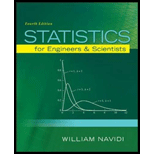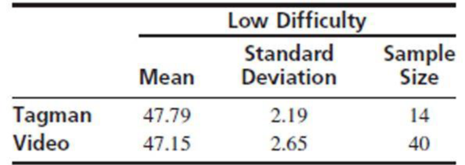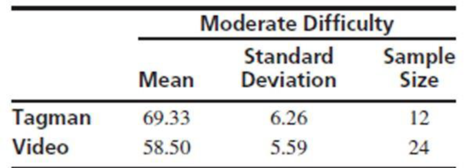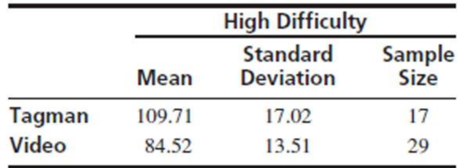
The article “Time Series Analysis for Construction Productivity Experiments” (T. Abdelhamid and J. Everett. Journal of Construction Engineering and Management. 1999:87–95) presents a study comparing the effectiveness of a video system that allows a crane operator to see the lifting point while operating the crane with the old system in which the operator relies on hand signals from a tagman. Three different lifts, A, B, and C, were studied. Lift A was of little difficulty, lift B was of moderate difficulty, and lift C was of high difficulty. Each lift was performed several times, both with the new video system and with the old tagman system. The time (in seconds) required to perform each lift was recorded. The following tables present the means, standard deviations, and



- a. Can you conclude that the
mean time to perform a lift of low difficulty is less when using the video system than when using the tagman system? Explain. - b. Can you conclude that the mean time to perform a lift of moderate difficulty is less when using the video system than when using the tagman system? Explain.
- c. Can you conclude that the mean time to perform a lift of high difficulty is less when using the video system than when using the tagman system? Explain.
a.
Check whether there is evidence to conclude that the mean time to perform a lift of low difficulty is less when using the video system than when using the tagman system.
Answer to Problem 4E
There is no evidence to conclude that the mean time to perform a lift of low difficulty is less when using the video system than when using the tagman system.
Explanation of Solution
Given info:
Three different lifts, A, B, and C, were studied in the given experiment. Lift A was of little difficulty, lift B was of moderate difficulty, and lift C was of high difficulty. The summary statistics for three lifts are given below:
Low difficulty:
Tagman:
Video:
Moderate difficulty:
Tagman:
Video:
High difficulty:
Tagman:
Video:
Calculation:
State the test hypotheses.
Null hypothesis:
Alternative hypothesis:
Tests statistic and P-value:
Software Procedure:
Step-by-step procedure to obtain the test statistic using the MINITAB software:
- Choose Stat > Basic Statistics > 2-Sample t.
- Choose Summarized data.
- In first, enter Sample size as 14, Mean as 47.79, Standard deviation as 2.19.
- In second, enter Sample size as 40, Mean as 47.15, Standard deviation as 2.65.
- Choose Options.
- In Confidence level, enter 95.
- In Alternative, select greater than.
- Click OK in all the dialogue boxes.
Output using the MINITAB software is given below:

From the MINITAB output, the test statistic is 0.89 and the P-value is 0.191.
Conclusion:
The P-value is 0.191 and the significance level is 0.05.
Here, the P-value is greater than the significance level.
That is,
Therefore, the null hypothesis is not rejected.
Thus, there is no evidence to conclude that the mean time to perform a lift of low difficulty is less when using the video system than when using the tagman system.
b.
Check whether there is evidence to conclude that the mean time to perform a lift of moderate difficulty is less when using the video system than when using the tagman system.
Answer to Problem 4E
There is evidence to conclude that the mean time to perform a lift of moderate difficulty is less when using the video system than when using the tagman system.
Explanation of Solution
Calculation:
State the test hypotheses.
Null hypothesis:
Alternative hypothesis:
Tests statistic and P-value:
Software Procedure:
Step-by-step procedure to obtain the test statistic using the MINITAB software:
- Choose Stat > Basic Statistics > 2-Sample t.
- Choose Summarized data.
- In first, enter Sample size as 12, Mean as 69.33, Standard deviation as 6.26.
- In second, enter Sample size as 24, Mean as 58.50, Standard deviation as 5.59.
- Choose Options.
- In Confidence level, enter 95.
- In Alternative, select greater than.
- Click OK in all the dialogue boxes.
Output using the MINITAB software is given below:

From the MINITAB output, the test statistic is 5.07 and the P-value is 0.000.
Conclusion:
The P-value is 0.000 and the significance level is 0.05.
Here, the P-value is less than the significance level.
That is,
Therefore, the null hypothesis is rejected.
Thus, there is evidence to conclude that the mean time to perform a lift of moderate difficulty is less when using the video system than when using the tagman system.
c.
Check whether there is evidence to conclude that the mean time to perform a lift of high difficulty is less when using the video system than when using the tagman system.
Answer to Problem 4E
There is evidence to conclude that the mean time to perform a lift of high difficulty is less when using the video system than when using the tagman system.
Explanation of Solution
Calculation:
State the test hypotheses.
Null hypothesis:
Alternative hypothesis:
Tests statistic and P-value:
Software Procedure:
Step-by-step procedure to obtain the test statistic using the MINITAB software:
- Choose Stat > Basic Statistics > 2-Sample t.
- Choose Summarized data.
- In first, enter Sample size as 17, Mean as 109.71, Standard deviation as 17.02.
- In second, enter Sample size as 29, Mean as 84.52, Standard deviation as 13.51.
- Choose Options.
- In Confidence level, enter 95.
- In Alternative, select greater than.
- Click OK in all the dialogue boxes.
Output using the MINITAB software is given below:

From the MINITAB output, the test statistic is 5.21 and the P-value is 0.000.
Conclusion:
The P-value is 0.000 and the significance level is 0.05.
Here, the P-value is less than the significance level.
That is,
Therefore, the null hypothesis is rejected.
Thus, there is evidence to conclude that the mean time to perform a lift of high difficulty is less when using the video system than when using the tagman system.
Want to see more full solutions like this?
Chapter 6 Solutions
Statistics for Engineers and Scientists
Additional Math Textbook Solutions
Thinking Mathematically (6th Edition)
Elementary Statistics: Picturing the World (7th Edition)
Elementary Statistics ( 3rd International Edition ) Isbn:9781260092561
Introductory Statistics
Calculus: Early Transcendentals (2nd Edition)
Mathematics for the Trades: A Guided Approach (11th Edition) (What's New in Trade Math)
- 5. Probability Distributions – Continuous Random Variables A factory machine produces metal rods whose lengths (in cm) follow a continuous uniform distribution on the interval [98, 102]. Questions: a) Define the probability density function (PDF) of the rod length.b) Calculate the probability that a randomly selected rod is shorter than 99 cm.c) Determine the expected value and variance of rod lengths.d) If a sample of 25 rods is selected, what is the probability that their average length is between 99.5 cm and 100.5 cm? Justify your answer using the appropriate distribution.arrow_forward2. Hypothesis Testing - Two Sample Means A nutritionist is investigating the effect of two different diet programs, A and B, on weight loss. Two independent samples of adults were randomly assigned to each diet for 12 weeks. The weight losses (in kg) are normally distributed. Sample A: n = 35, 4.8, s = 1.2 Sample B: n=40, 4.3, 8 = 1.0 Questions: a) State the null and alternative hypotheses to test whether there is a significant difference in mean weight loss between the two diet programs. b) Perform a hypothesis test at the 5% significance level and interpret the result. c) Compute a 95% confidence interval for the difference in means and interpret it. d) Discuss assumptions of this test and explain how violations of these assumptions could impact the results.arrow_forward1. Sampling Distribution and the Central Limit Theorem A company produces batteries with a mean lifetime of 300 hours and a standard deviation of 50 hours. The lifetimes are not normally distributed—they are right-skewed due to some batteries lasting unusually long. Suppose a quality control analyst selects a random sample of 64 batteries from a large production batch. Questions: a) Explain whether the distribution of sample means will be approximately normal. Justify your answer using the Central Limit Theorem. b) Compute the mean and standard deviation of the sampling distribution of the sample mean. c) What is the probability that the sample mean lifetime of the 64 batteries exceeds 310 hours? d) Discuss how the sample size affects the shape and variability of the sampling distribution.arrow_forward
- A biologist is investigating the effect of potential plant hormones by treating 20 stem segments. At the end of the observation period he computes the following length averages: Compound X = 1.18 Compound Y = 1.17 Based on these mean values he concludes that there are no treatment differences. 1) Are you satisfied with his conclusion? Why or why not? 2) If he asked you for help in analyzing these data, what statistical method would you suggest that he use to come to a meaningful conclusion about his data and why? 3) Are there any other questions you would ask him regarding his experiment, data collection, and analysis methods?arrow_forwardBusinessarrow_forwardWhat is the solution and answer to question?arrow_forward
- To: [Boss's Name] From: Nathaniel D Sain Date: 4/5/2025 Subject: Decision Analysis for Business Scenario Introduction to the Business Scenario Our delivery services business has been experiencing steady growth, leading to an increased demand for faster and more efficient deliveries. To meet this demand, we must decide on the best strategy to expand our fleet. The three possible alternatives under consideration are purchasing new delivery vehicles, leasing vehicles, or partnering with third-party drivers. The decision must account for various external factors, including fuel price fluctuations, demand stability, and competition growth, which we categorize as the states of nature. Each alternative presents unique advantages and challenges, and our goal is to select the most viable option using a structured decision-making approach. Alternatives and States of Nature The three alternatives for fleet expansion were chosen based on their cost implications, operational efficiency, and…arrow_forwardBusinessarrow_forwardWhy researchers are interested in describing measures of the center and measures of variation of a data set?arrow_forward
- WHAT IS THE SOLUTION?arrow_forwardThe following ordered data list shows the data speeds for cell phones used by a telephone company at an airport: A. Calculate the Measures of Central Tendency from the ungrouped data list. B. Group the data in an appropriate frequency table. C. Calculate the Measures of Central Tendency using the table in point B. 0.8 1.4 1.8 1.9 3.2 3.6 4.5 4.5 4.6 6.2 6.5 7.7 7.9 9.9 10.2 10.3 10.9 11.1 11.1 11.6 11.8 12.0 13.1 13.5 13.7 14.1 14.2 14.7 15.0 15.1 15.5 15.8 16.0 17.5 18.2 20.2 21.1 21.5 22.2 22.4 23.1 24.5 25.7 28.5 34.6 38.5 43.0 55.6 71.3 77.8arrow_forwardII Consider the following data matrix X: X1 X2 0.5 0.4 0.2 0.5 0.5 0.5 10.3 10 10.1 10.4 10.1 10.5 What will the resulting clusters be when using the k-Means method with k = 2. In your own words, explain why this result is indeed expected, i.e. why this clustering minimises the ESS map.arrow_forward
 Linear Algebra: A Modern IntroductionAlgebraISBN:9781285463247Author:David PoolePublisher:Cengage Learning
Linear Algebra: A Modern IntroductionAlgebraISBN:9781285463247Author:David PoolePublisher:Cengage Learning Big Ideas Math A Bridge To Success Algebra 1: Stu...AlgebraISBN:9781680331141Author:HOUGHTON MIFFLIN HARCOURTPublisher:Houghton Mifflin Harcourt
Big Ideas Math A Bridge To Success Algebra 1: Stu...AlgebraISBN:9781680331141Author:HOUGHTON MIFFLIN HARCOURTPublisher:Houghton Mifflin Harcourt Functions and Change: A Modeling Approach to Coll...AlgebraISBN:9781337111348Author:Bruce Crauder, Benny Evans, Alan NoellPublisher:Cengage Learning
Functions and Change: A Modeling Approach to Coll...AlgebraISBN:9781337111348Author:Bruce Crauder, Benny Evans, Alan NoellPublisher:Cengage Learning


